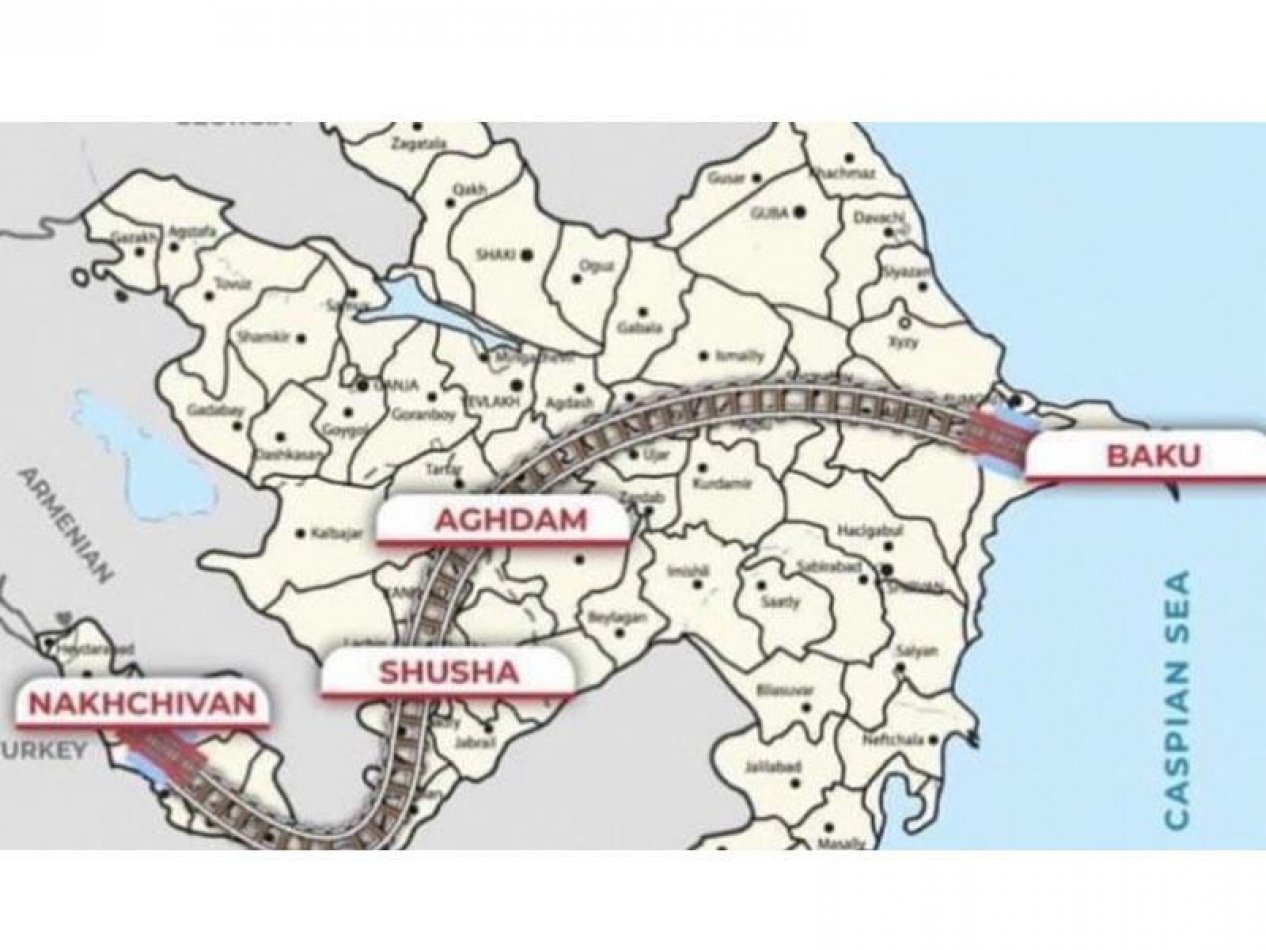
Azerbaijan is promoting “corridor logic” to disrupt negotiations on unblocking communications in the region, Armenian Prime Minister Nikol Pashinyan said November 23, answering questions from media and public organizations during a live broadcast on Facebook. At the same time, Pashinyan noted that Armenia, perhaps more than other countries, is interested in opening communications in the region. Most likely, Azerbaijan is promoting this logic in order to close the topic of unblocking roads. But Yerevan will do everything to prevent Baku from succeeding, the head of the Armenian government assured.
Faktyoxla Lab. has tried to figure out how plausible the statements of the Armenian prime minister are.
Let’s start with the fact that, firstly, this is not Pashinyan’s first statement that Armenia doesn’t allow the establishment of any uncontrolled transport corridors through its territory. That is, he refuses to comply with the relevant clause of the trilateral statement. According to experts, this can exempt Azerbaijan from responsibility. We are talking about the Lachin corridor, which runs through the sovereign territory of Azerbaijan. In fact, both corridors - the Zangezur corridor and the Lachin corridor - are virtually identical. In the Lachin corridor, the safety of the passage of goods and people is guaranteed by the Azerbaijani side, with the actual presence of Russian peacekeepers, the same applies to the Zangezur corridor - Armenia guarantees the safety of the passage of goods and people, with the participation of the border troops of the Federal Security Service of the Russian Federation. If there is a Lachin corridor, accordingly, there must be a Zangezur corridor.
Moreover, the very tripartite statement dated November 9-10, 2020 doesn’t mention the inadmissibility of the establishment of mechanisms of state control (points of customs, passport, phytosanitary control) by Azerbaijan on the Lachin section of the state border at the entrance to the Lachin corridor. The signed document is only about communication with Armenia and security.
The trilateral statement reads: “The Lachin Corridor (5 km wide), which will provide a connection between Nagorno-Karabakh and Armenia while not passing through the territory of Shusha, shall remain under the control of the Russian Federation peacemaking forces. As agreed by the Parties, within the next three years, a plan will be outlined for the construction of a new route via the Lachin Corridor, to provide a connection between Nagorno-Karabakh and Armenia, and the Russian peacemaking forces shall be subsequently relocated to protect the route. The Republic of Azerbaijan shall guarantee the security of persons, vehicles and cargo moving along the Lachin Corridor in both directions.”
The document doesn’t say anything about the inadmissibility of the establishment of mechanisms of state control by Azerbaijan at the border, that is, at the entrance. At the same time, control along the entire road remains with the Russian peacekeeping contingent. The establishment of a checkpoint doesn’t violate the signed statement.
Secondly, the issue of communications between Azerbaijan and the Nakhchivan Autonomous Republic is undoubtedly outlined in the trilateral statement of November 10. It has clause 9, which reads as follows: “All economic and transport connections in the region shall be unblocked. The Republic of Armenia shall guarantee the security of transport connections between the western regions of the Republic of Azerbaijan and the Nakhchivan Autonomous Republic in order to arrange unobstructed movement of persons, vehicles and cargo in both directions. The Border Guard Service of the Russian Federal Security Service shall be responsible for overseeing the transport connections. As agreed by the Parties, new transport links shall be built to connect the Nakhchivan Autonomous Republic and the western regions of Azerbaijan.”
There is no need to further explain what is meant by “transport links shall be built to connect the Nakhchivan Autonomous Republic and the western regions of Azerbaijan.”
By capturing the Zangilan, Jabrayil and Fuzuli districts, Armenia established control over 120 kilometers of the Azerbaijani-Iranian border, along which the railway passed. During the years of occupation, the Armenians completely dismantled the tracks both in the occupied area and in Meghri itself, having sold both rails and sleepers.
The very topic of such a corridor didn’t appear on the agenda today. For example, after meetings in Paris and Key West in 2001, the Armenian side, represented by Robert Kocharyan, agreed to exchange corridors – the Lachin one in exchange for Meghri (Zangezur), but then backed down, fearing the opposition’s reaction. It is also known about the existence of the so-called Goble Plan, which suggested exchanging a narrow strip on the Armenian-Iranian border for Nagorno-Karabakh with the Lachin corridor. Then, thinking that this option deprives Armenia of the border with Iran and contributes to the ‘pan-Turkist idea,’ Goble created another plan – ‘Goble-2,’ even more insane and leaving Azerbaijan without a border with Turkey after obtaining the Meghri corridor.
Thirdly, in Soviet times there were two entrances from Azerbaijan to Armenia. The first one from the south was through the Azerbaijani districts liberated from occupation, from which the path goes to the territory of Zangezur (Syunik region of Armenia). It is the shortest way to the Nakhchivan Autonomous Republic. The second one from the north is via the Gazakh district. To get to Nakhchivan along this route, it is necessary to travel practically across the entire territory of Armenia. Azerbaijan is in favor of prioritizing the southern section, because it is shorter and creates conditions for an infrastructure project to be implemented in the liberated districts. In the future, it is possible to open the way in both directions. But at the first stage, the Azerbaijani side is in favor of the southern route. Money has already been allocated for the construction of a railway line, which was destroyed during the war, and a highway to the border with Armenia.
Now a few words about the term “corridor” and “extraterritorial.” There is no convention in international law that defines the word “corridor.” So, everyone has their own understanding of this term.
Today, the territory of the EAEU, which includes Armenia, has a network of the most important transcontinental international transport corridors as part of roads and railways, inland waterways and air routes. For example, 11 international transport corridors pass through the territory of Kazakhstan, of which five are railways and six are highways.
This is while the Transportation Corridor East-West (Lapis Lazuli, Black Sea-Caspian Sea, China-Uzbekistan-Azerbaijan), North-West, North-South and South-West international transport corridors pass through the territory of Azerbaijan.
These corridors are not considered ‘extraterritorial’ and cannot be considered such, since there is no such concept and it is invented by the Armenian side. Since Armenia will also use the Zangezur corridor, the question of the so-called extraterritoriality is removed automatically.
So, the conversation about the Zangezur corridor by Azerbaijan is being raised quite rightfully in the context of the restoration of transport links in the post-conflict period. Therefore, initially, no one had any doubts about the presence of such an issue on the agenda, especially since it is written in the text of the trilateral statement. Foreign media and experts noted that Azerbaijan, having agreed to the compact residence of Armenians in Karabakh, will receive in return actual territorial gain: a transport corridor from the main territory of Azerbaijan to its exclave Nakhchivan through the territory of Armenia. Without questioning the appearance of such a corridor, media outlets wrote that the revival of transport and cargo communication between Azerbaijan and its autonomous region would be controlled by Russian border guards.
Summing up, it is safe to say that there is an agreement on the construction of a railway and a highway in Nakhchivan. It is envisaged in the trilateral statement dated November 10 last year and is on the agenda of a trilateral working group at the level of deputy prime ministers of the governments of Azerbaijan, Russia and Armenia. So, it is Armenia that disrupts negotiations on unblocking communications in the region.




















